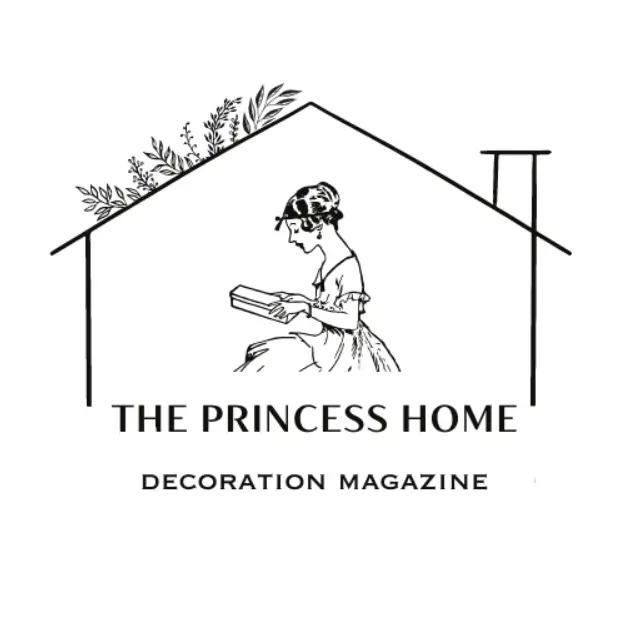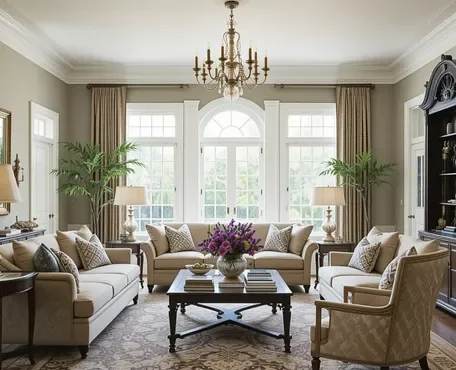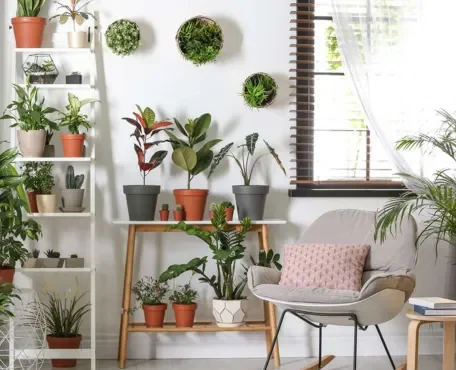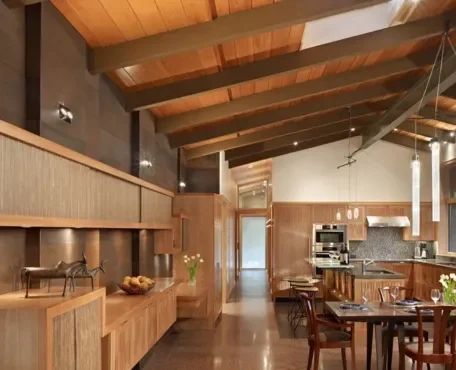
Biophilic Style: Best Ideas to Integrate It into Home Design
In today’s tech-driven world, biophilic design meets the growing desire to reconnect with nature by integrating natural elements into spaces to boost well-being, productivity, and creativity. Rooted in the concept of “biophilia,” our innate affinity for nature, this approach blends indoor and outdoor environments to enhance both life quality and the living space. This word (biophilic) is derived from Latin origins meaning love of life.
In this detailed guide, we’ll explore the best ideas for infusing biophilic style into your home design, from simple decorative elements to larger architectural changes.
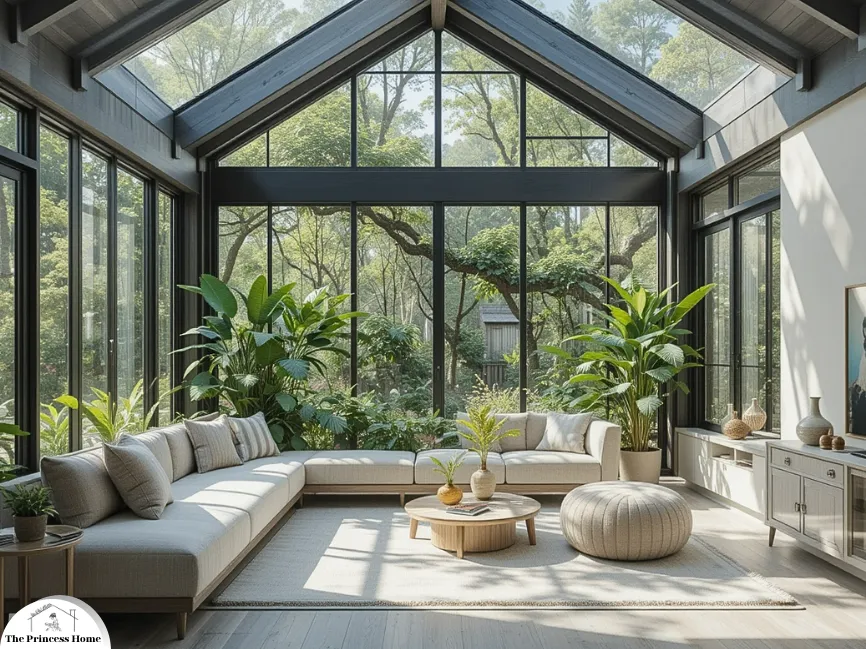
1. Maximize Natural Light
One of the foundational principles of biophilic design is to make the most of natural light. Daylight has a profound impact on mood, energy levels, and circadian rhythms, which regulate sleep patterns and overall health. Ideas for Integrating Natural Light:

Large Windows & Glass Walls:
Maximize the amount of natural light by incorporating expansive windows or even glass walls. Consider sliding doors, French windows, or floor-to-ceiling windows to seamlessly connect your interior with the outdoor world.

Skylights & Light Wells:
If you’re working with limited wall space or a small home, consider adding skylights or light wells. These can brighten up dark corners or hallways, providing natural illumination without compromising privacy.

Mirrors to Reflect Light:
Strategically place mirrors across from windows to reflect natural light deeper into your rooms. This simple trick can help make your space feel brighter and more expansive.

Sheer Curtains:
Instead of heavy drapes, opt for sheer or translucent window treatments to diffuse sunlight while still maintaining privacy.
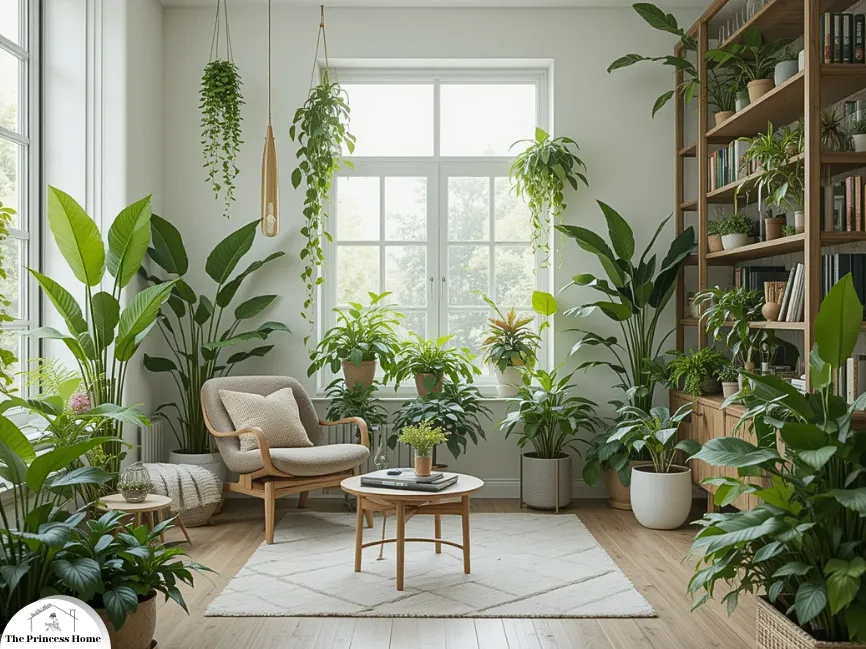
2. Indoor Plants &Greenery
No discussion of biophilic design is complete without mentioning plants. Indoor greenery not only enhances the aesthetics of a space but also improves air quality, reduces stress, and increases overall well-being. Ideas for Incorporating Plants:

Vertical Gardens:
Use plant walls or green panels for a striking visual effect. Vertical gardens allow you to integrate a variety of plants into even small spaces.

Hanging Planters:
Hanging planters add a whimsical touch and can free up floor space, making them ideal for apartments or small homes.

Indoor Trees:
Consider adding large indoor trees, such as a fiddle-leaf fig or a rubber plant, to create a focal point and bring a sense of serenity to the room.

Herb Gardens:
In the kitchen, an herb garden can be both practical and decorative. Consider placing small planters on windowsills or creating a dedicated garden in a sunny corner of the kitchen.
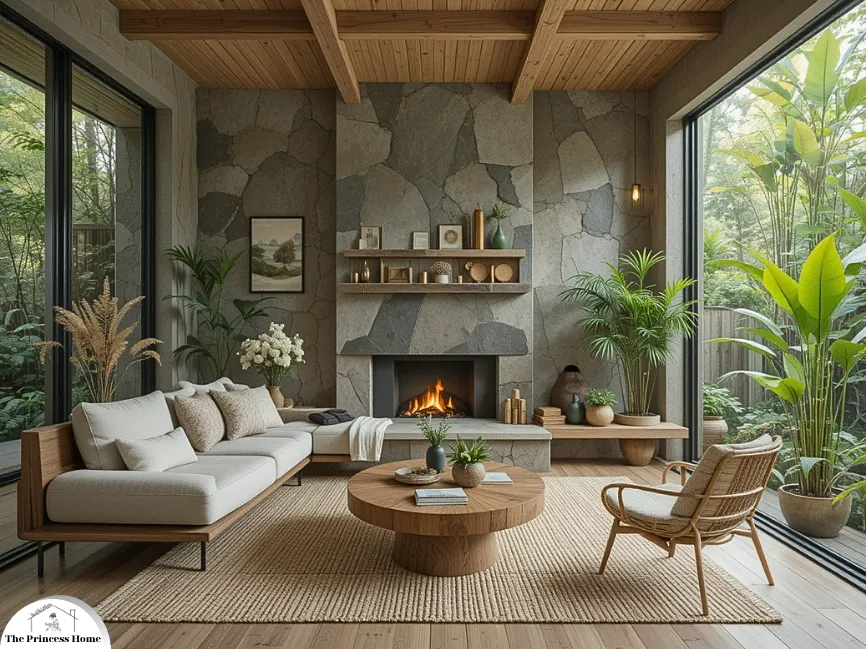
3. Natural Materials &Textures
Biophilic design seeks to emulate nature’s textures and colors, and one of the best ways to achieve this is through natural materials. Whether it’s wood, stone, or bamboo, materials sourced from nature not only create a connection to the outdoors but also add depth, warmth, and a tactile quality to your home. Ideas for Using Natural Materials:

Wooden Elements:
Wood is one of the most versatile and common materials in biophilic design. Use it for flooring, accent walls, ceiling beams, or furniture. Reclaimed wood, in particular, adds character and history to a room.

Stone and Marble:
Incorporating stone or marble into your home—whether as a feature wall, a countertop, or decorative accessories—can give your space a grounded, earthy feel.

Bamboo and Cork:
Bamboo is a sustainable material that adds a unique aesthetic to interiors. It works well in areas like kitchens and bathrooms, as well as on floors and walls. Cork, too, is gaining popularity for its eco-friendly qualities and distinctive look.

Textiles with Organic Fibers:
Use natural fibers like cotton, linen, wool, and hemp for upholstery, bedding, and rugs. These materials evoke a sense of comfort and simplicity while staying aligned with biophilic principles.
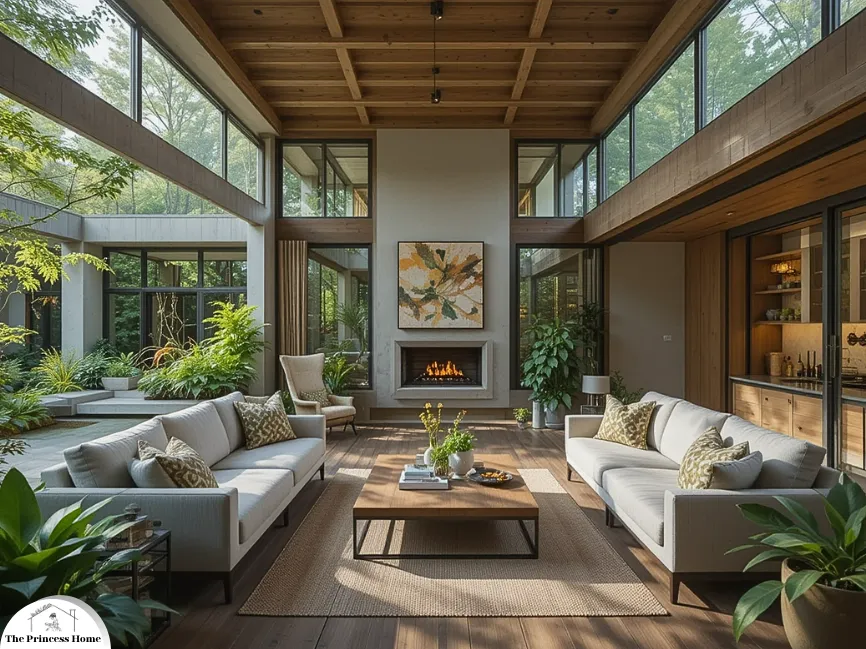
4. Indoor-Outdoor Connection
Creating a seamless connection between your indoor living spaces and the outdoor environment is a key tenet of biophilic design. This can help you feel more connected to nature, regardless of the weather or season. Ideas for Strengthening Indoor-Outdoor Connections:

Sliding Glass Doors:
Install sliding or folding glass doors that open up to your garden, patio, or balcony, blurring the line between indoors and outdoors.

Outdoor Rooms:
If you have outdoor space, create “outdoor rooms” complete with comfortable seating, weatherproof furniture, and greenery. A deck or terrace can be turned into a cozy dining or relaxation area that feels like an extension of your home.

Landscaped Courtyards:
Create small courtyards or garden spaces that can be accessed from multiple rooms in your home, allowing you to enjoy nature from different angles.

Views of Nature:
Position key seating areas (like a dining table or living room chair) to face a garden, water feature, or even urban greenery like a park.
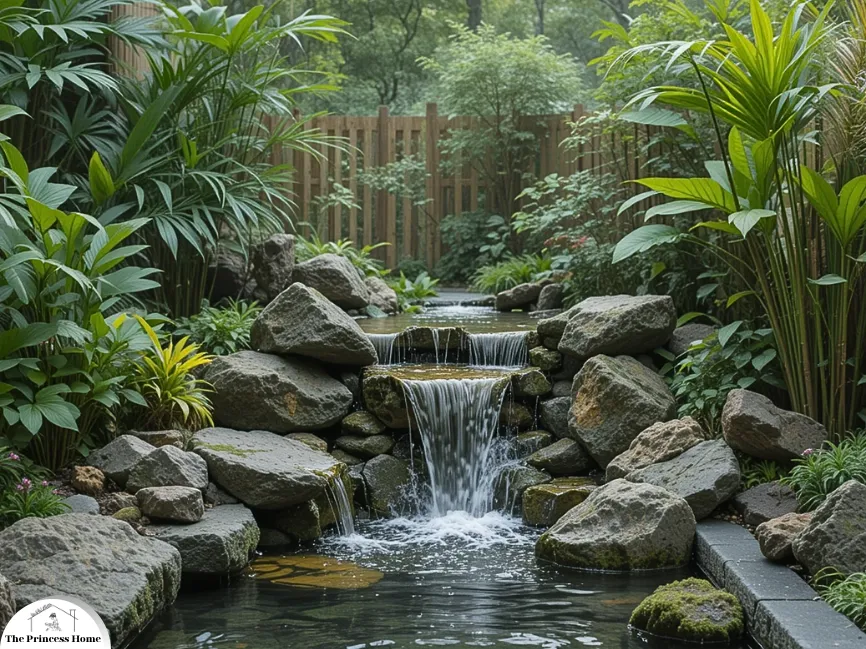
5. Water Features
The sound of water has a calming effect, and incorporating water features into your home can help foster relaxation and tranquility. Water not only engages the senses but also introduces another natural element into your living space. Ideas for Adding Water Features:

Indoor Fountains:
A tabletop or wall-mounted fountain can add both aesthetic and auditory appeal to a space. The gentle sound of flowing water can reduce stress and create a peaceful atmosphere.

Pond or Pool:
If you have the outdoor space, consider installing a pond or swimming pool with natural landscaping to create a serene retreat just outside your door.

Aquariums:
While not technically a water “feature,” an aquarium can introduce the soothing effects of water while providing visual interest and a sense of calm.

6. Biophilic Color Palette
Colors have a significant impact on mood and perception, and biophilic design leverages nature’s color palette to bring the outdoors inside. Earthy tones and shades inspired by the natural world can help create a calm and grounded atmosphere. Ideas for a Biophilic Color Palette:

Earthy Greens:
Shades of green, from sage to emerald, mimic the hues of plants and trees and can be incorporated into walls, textiles, and decor to evoke a sense of lushness and vitality.

Warm Neutrals:
Soft, warm neutrals such as beiges, tans, and browns mimic the colors of wood, stone, and sand, creating a grounded, earthy feel.

Blues and Teals:
Blues evoke the calming effect of water and sky. Whether it’s a muted teal or a deep navy, these colors can bring a tranquil, open feeling to any space.

Natural Whites:
Whites that resemble the color of natural light or the stone of mountain peaks can create an airy, open space and enhance the sense of brightness and cleanliness.

7. Natural Forms & Organic Shapes
Biophilic design often embraces organic forms and shapes that mimic the curves and irregularity found in nature. Instead of sharp angles and rigid lines, consider using rounded furniture, curvaceous architectural elements, and naturally shaped accessories. Ideas for Introducing Organic Shapes:

Rounded Furniture:
Opt for sofas, tables, and chairs with softer, rounded edges to create a more relaxed, inviting atmosphere.

Irregular Patterns:
Incorporate textiles and decor with irregular, flowing patterns that resemble natural formations such as leaves, waves, or tree bark.

Sculptural Elements:
Sculptural elements such as curved staircases, flowing drapery, or nature-inspired art pieces can soften the space and give it an organic feel.
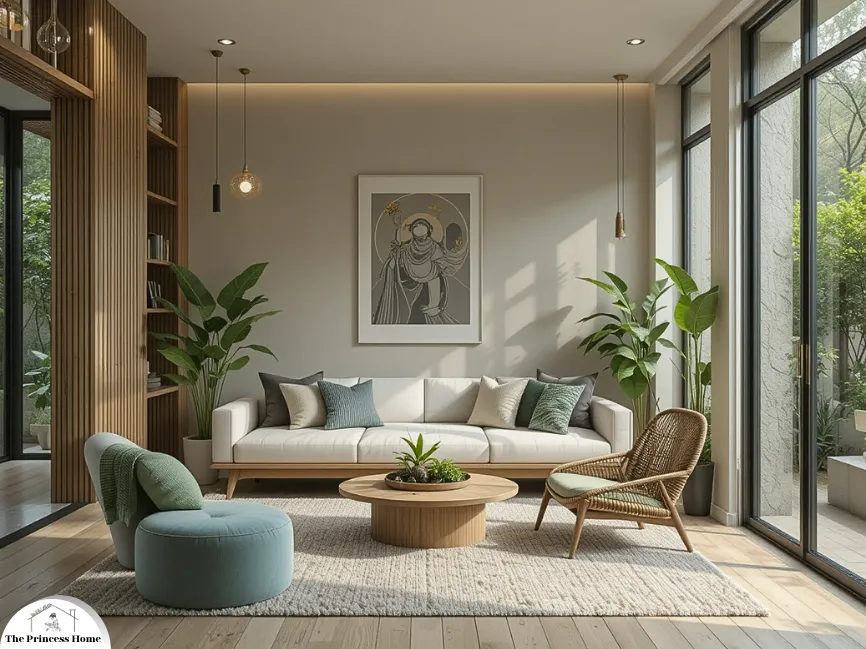
8. Sustainability &Eco-Friendly Design
Biophilic design doesn’t just focus on aesthetics; it also emphasizes sustainability. Using eco-friendly materials, energy-efficient appliances, and green technologies ensures that your design choices contribute to a healthier planet. Ideas for Sustainable Design Choices:

Recycled Materials:
Choose furniture and decor made from recycled or upcycled materials to minimize your ecological footprint.

Energy-Efficient Systems:
Invest in energy-efficient lighting, appliances, and heating/cooling systems that help reduce your home’s environmental impact.

Solar Panels:
Installing solar panels on your roof can harness the sun’s energy, making your home more eco-friendly and reducing your reliance on fossil fuels.
Conclusion
Biophilic design is all about creating spaces that enhance our connection to nature. By integrating natural elements, light, and materials into your home, you can create a serene and health-promoting environment that not only looks beautiful but also contributes to your well-being. Whether through maximizing natural light, introducing plants, or incorporating sustainable practices, there are countless ways to bring the outdoors in and create a home that nurtures both the body and the mind.
Here are some frequently asked questions related to the article :
1. What is biophilic design?
Biophilic design is an architectural and interior design approach that incorporates elements of nature into built environments to improve well-being, enhance creativity, and foster a connection with the natural world.
2. How can I incorporate biophilic design into my home?
You can integrate biophilic design into your home by:
- Adding plants and greenery.
- Maximizing natural light with large windows or skylights.
- Using natural materials like wood, stone, or bamboo.
- Introducing water features like fountains or aquariums.
- Opting for nature-inspired colors and patterns in decor.
3. Do I need a large budget to implement biophilic design?
Not at all! Small changes, like adding houseplants, rearranging furniture to access more natural light, or using nature-inspired artwork and textiles, can make a big impact without a significant investment.
4. Can biophilic design work in small spaces?
Yes! Vertical gardens, hanging plants, mirrors to amplify natural light, and multi-functional furniture made from natural materials are great ways to incorporate biophilic design in small spaces.
5. What are the benefits of biophilic design?
Reduce stress and improve mental well-being. Increase productivity and creativity. Enhance indoor air quality. Create a calming and harmonious living environment.
6. What type of plants are best for biophilic design?
Low-maintenance indoor plants like pothos, snake plants, ferns, and peace lilies are excellent options. Choose plants that suit the lighting and humidity conditions of your space.
7. Can I use artificial plants in biophilic design?
While artificial plants can mimic the look of greenery, they lack the air-purifying and psychological benefits of real plants. However, they can be a good option for areas with poor lighting or for those without a green thumb.
8. How does biophilic design contribute to sustainability?
Biophilic design often emphasizes the use of natural, renewable, and eco-friendly materials, which reduces the environmental impact of home design. It also encourages practices like water conservation through rain gardens and efficient irrigation systems.
9. Can biophilic design be integrated with modern interiors?
Absolutely! Modern interiors and biophilic design can work beautifully together. Opt for sleek planters, minimalist furniture made from natural materials, and clean-lined designs that incorporate natural light and greenery.
10. Is biophilic design only for residential spaces?
No, biophilic design is widely used in offices, schools, hospitals, and public spaces to improve the environment and promote well-being.

